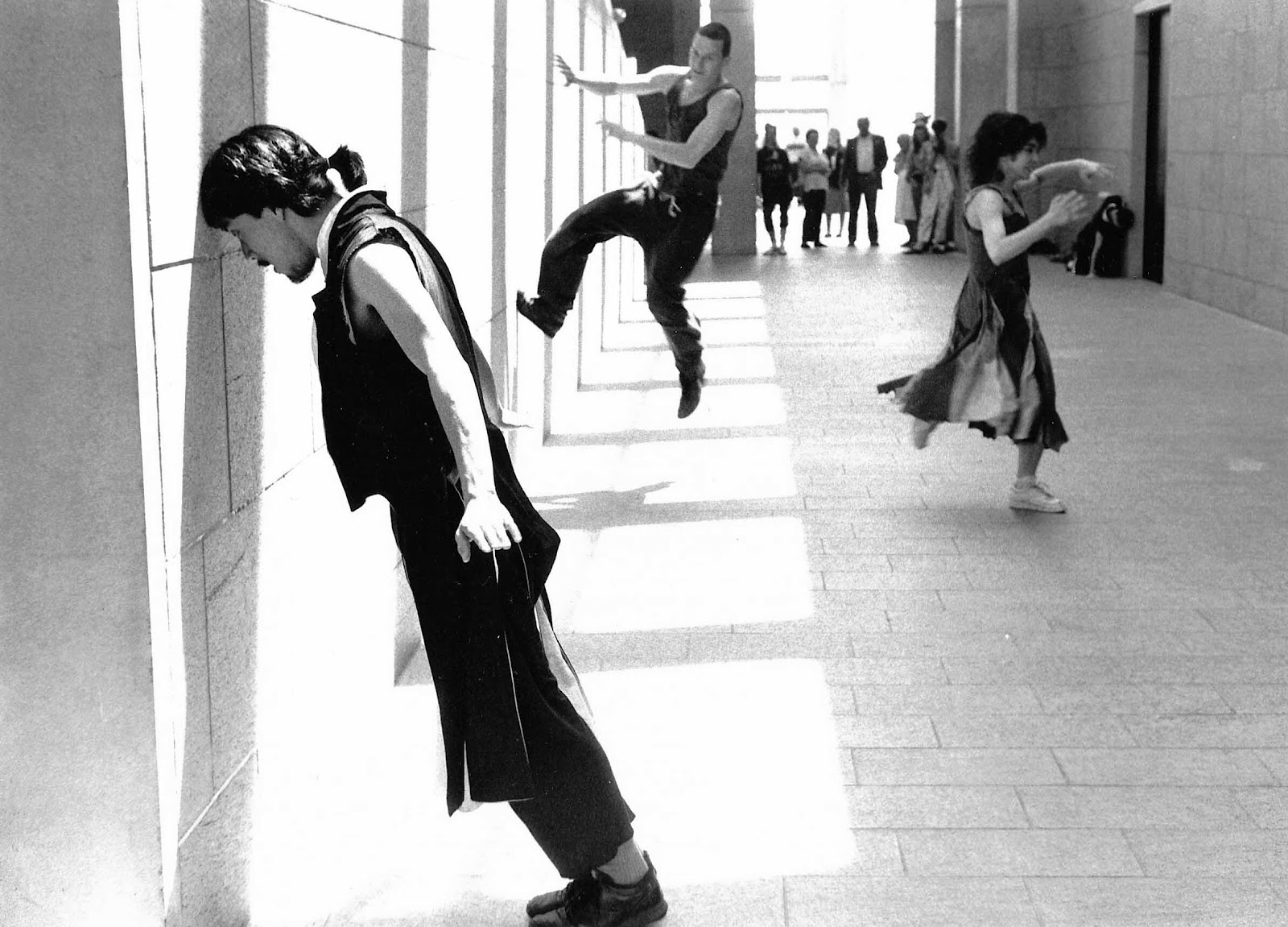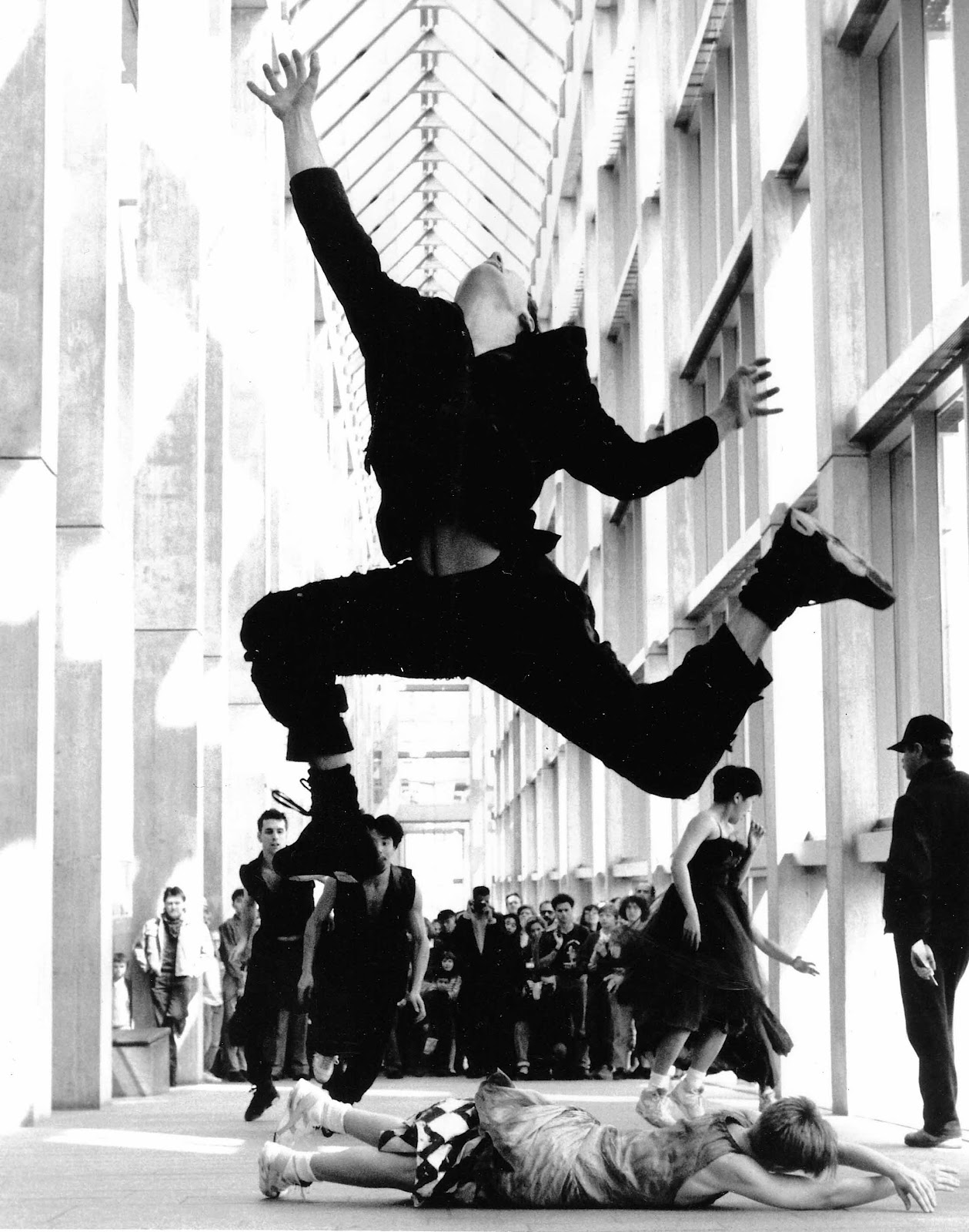Passage

Passage
Premiere performance National Gallery of Canada 1990
Canada Dance Festival
About
A commission from National Gallery of Canada to create a site-specific work to accompany a show on Emily Carr, lead to the creation of Passage. The focus of the work was to develop the dancers as conduits for the spirit of the architectural space by Moshe Safdie, and how the audience could encounter this spirit through their own bodies as they occupied the same space as the dancers. The company was given a four-week residency in the gallery to create the work on site, followed by a two-week performance run.
What was wholly unexpected was how the army of guards, who ran the gallery, became more and more involved in the work as it was being created and eventually took ownership of the piece and became an integral part of it. They created another level of reality and meaning. Passage provided the first experience of the power and potential of community dance and initiated a major shift in the focus of KJD work.
We were forbidden to use the gallery spaces where the art was and limited to the public spaces. Even there, the guards were extremely uncomfortable with dancers running and jumping around in the public spaces of the gallery. Over the course of the creation period, this relationship of the guards to the dance underwent a radical transformation. Their interest grew and the guards began to take ownership of the work as it emerged, guiding the public to the best vantage point to observe the creation and rehearsal processes, and eventually becoming an integral part of the final choreographic form.
The guards became a layer of the work that interfaced directly with the audience adding a whole new dimension, enriching the piece. Passage was a hit and audiences came back to see more than one performance. The following year, the National Gallery brought the company back to do another extended run and the guards celebrated the dancer’s return with a party.
Passage provided the first experience of the power and potential of community dance and initiated a major shift in the focus of KJD work.
The People
Choreography: Karen Jamieson
Performers: Andrew Olewine, Catherine Lubinsky, Alan Dobbs, Kay Huang, Virginia Corcoran, Hiromoto Ida, Karen Jamieson
Music: Jeff Corness
Costumes: Susan Berganzi
Reviews
“People who travel into the rain forest that Emily Carr used to paint - who feel it around them ‘full of unseen things and great silences’ - know how fully her work captures the essence of that mysterious countryside. In Passage, a site-specific dance work at the National Gallery of Canada, Vancouver choreographer Karen Jamieson shows that she has an equally profound sympathy for place. As the dancers reach the interior rotunda, one falls lifeless, his journey ended. In one of the most transcendent passages of dance Jamieson has ever created, the other performers climb into the rotunda where they begin to chant a mantra of Om and the calls of forest birds. While their keening resonates in that extraordinary sanctuary, the motionless body below them is slowly restored to life. Emily Carr, who spent most of her life seeking after a god she believed to cloak himself in nature, would have found great comfort in Passage's hopeful message.”
- Dance Connection
"Passage contained much to engage the mind, as well as the body. Passing along one of the steep sided corridors half an hour after the show, I saw a couple engaging in some mimed sword-play. I don't know whether they had seen the piece, or whether they were responding the to the newly animated feeling of the corridor, which no longer seemed like a mere conduit to The Place Where The Art lives. Thanks to Jamieson, live kinetic art has infiltrated the temple of static artifacts, and it felt good."
- Globe and Mail
"The piece I was most happy to see was Karen Jamieson's Passage, a site specific work for the glass enclosed National Gallery...Why was this [piece] so satisfying? ...Jamieson used the museum space beautifully, responding to the space's temptations with humor and recklessness, doing some of the athletic things we're tempted to do in that kind of space but know we¹re not suppose to. Passage kept changing its character becoming graver as we approached the inner chamber, but it had a kind of warmth and spontaneity of feeling that prevented it from becoming gimmicky or mechanical. And the sincerity of Jamieson's excellent dancers - their commitment and enjoyment - gave it heart."
- The Village Voice
“Jamieson and composer Jeff Corness have created a haunting, evocative homage to Carr, who died in 1945. This is a dance about soaring, about reaching up beyond the bounds of normal restraint. It’s clear Jamieson is as fascinated by Carr’s psychological struggle towards goals as she is by her art.
Jamieson lets the six dancers play with surfaces; flat on their stomachs they scale the sloping floor of the Colonnade as though they’re climbing Mount Everest. Later, they jump up to clutch the floor of the next gallery level and hang motionless. All the while, Jamieson climbs a rope suspended from the ceiling in a scene of seeming risk and danger….The dancers move from the Colonnade to the Great Hall, assembling into living, moving totem poles on the granite slabs.
Although they enter each new space with caution, the dancers soon take it over completely, running in large circles or throwing themselves up and off the walls. There is a dark side, however; an image of the tortured soul of the woman, writhing in anguish as she is regarded coldly by the others perched a storey above her. The piece ends with the dancers walking slowly back down the Colonnade.
A rich and interesting work; for me, one of the highlights of the Canada Dance Festival.”
- The Ottawa Citizen
June 29, 1990
By Andrew Rowe
Please note that populating the Karen Jamieson Dance website with new information and images from the archives is an ongoing process that we are undertaking as fast as we can. Karen Jamieson Dance welcomes any corrections or missing information to the description and acknowledgments listed above. These can be forwarded to admin@kjdance.ca







